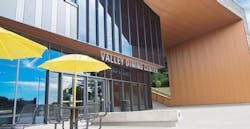Dining facility at Western Michigan University receives LEED Gold
The Valley Dining Center at Western Michigan University in Kalamazoo has received LEED Gold certification for its sustainable design and construction.
The university says the certification was a significant achievement for a dining facility because of the complexity of its mechanical, electrical and plumbing systems, as well as the challenges dealing with energy use and waste in a high-capacity food service facility.
"We are so proud to have been awarded LEED Gold certification," says Diane Anderson, vice president for student affairs. "This means we have succeeded in our commitment to advance environmental sustainability practices, while offering students an incredible space to gather and dine in the Valley Neighborhood."
The two-story, 61,152-square-foot dining facility opened in 2016 to serve university students, faculty, staff and visitors in the Valley Residential Neighborhood. It has a capacity of little more than 1,000. The second floor features nine distinct food venues with fresh menu items prepared in a restaurant-style dining environment. The ground floor includes Café 1903, a convenience store and café, public gathering spaces and seating.
Among the sustainability features in the Valley Dining Center:
- An exterior living wall and green roof.
- A sustainable rain garden that helps keep 100 percent of stormwater on site.
- Landscaping designed to be drought-tolerant and require little to no irrigation.
- Energy-efficient heating, ventilation, air conditioning, lighting and water systems.
- A food pulper and water extraction system that can reduce the typical food and scrap volume by 87 percent and save about 83 percent of the water.
- Harvesting, reclaiming or extracting as well as manufacturing 33 percent of building materials within 500 miles of the site.
- Dishwashers with energy-recovery units that use the steam generated during operation to pre-heat the water for further operations.
- Customizable made-to-order food options, right-sized portion and tray-less dining to help reduce food waste.
- Consolidation of dining facilities to enhance the collection of recyclable materials and post-consumer food waste.
The project architect is SmithGroupJJR.
About the Author
Mike Kennedy
Senior Editor
Mike Kennedy, senior editor, has written for AS&U on a wide range of educational issues since 1999.
